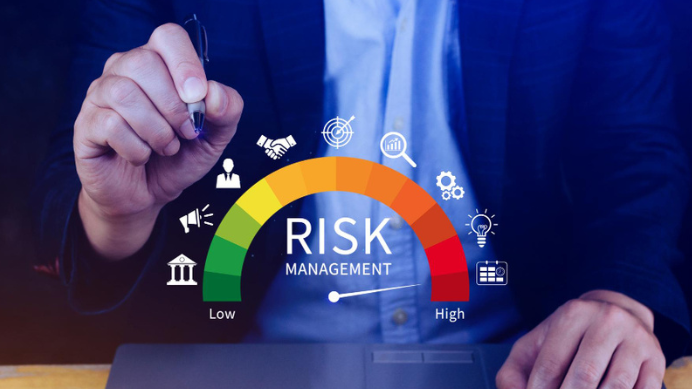
AI in Risk Management – Key Use Cases
Artificial intelligence in risk management is transforming how organizations identify, assess, and mitigate risks by leveraging advanced algorithms, machine learning, and data analytics.
Unlike traditional risk management approaches that rely heavily on manual processes and historical data, AI and risk management integrate real-time data processing and predictive analytics to detect patterns and foresee potential threats with greater accuracy and speed.
This dynamic capability enables businesses to proactively manage risks across various domains such as finance, healthcare, manufacturing, and supply chains, enhancing decision-making and operational resilience.
By automating routine tasks, improving fraud detection, and enabling customizable risk models, AI in risk management not only reduces human error but also transforms risk mitigation into a more efficient and adaptive process.
What is AI in Risk Management?
AI in risk management refers to the use of artificial intelligence technologies—such as machine learning, data analytics, natural language processing, and advanced algorithms—to detect, evaluate, and minimize risks across various domains.
By analyzing large volumes of structured and unstructured data, AI systems can identify patterns, spot anomalies, and forecast potential threats with high precision, enabling organizations to move from reactive to proactive risk management.
Why is AI in Risk Management important?
AI in risk management is important because it improves an organization’s ability to identify, assess, and mitigate risks with greater speed, accuracy, and efficiency than traditional methods.
By leveraging AI technologies such as machine learning and predictive analytics, businesses can analyze vast amounts of data in real time to detect emerging threats, fraudulent activities, compliance breaches, and operational inefficiencies that might otherwise go unnoticed.
This proactive risk detection enables faster decision-making and more effective allocation of resources, helping organizations to reduce potential losses and improve resilience against disruptions.
Moreover, AI automates routine and time-consuming tasks like regulatory compliance checks, document review, and risk reporting, freeing risk professionals to focus on strategic and high-priority issues.
In cybersecurity, AI continuously monitors network behavior to identify anomalies and adapt to evolving threats, strengthening defenses against sophisticated attacks. Additionally, AI-driven risk management supports predictive insights and scenario simulations, allowing businesses to anticipate future risks and adjust strategies accordingly.
Use cases of AI in Risk Management
The use cases of AI in Risk Management include the following
1. Fraud detection and prevention in banking
AI in risk management is transforming fraud detection by leveraging machine learning algorithms to analyze large datasets and recognize suspicious activities in real time. AI models can differentiate between legitimate and fraudulent transactions, automatically flagging anomalies and blocking suspicious activities before they result in financial loss.
These systems continuously learn from new data, adapting to evolving fraud tactics and reducing false positives, which improves both security and customer experience. Major banks and payment platforms have reported significant reductions in fraud-related losses after implementing AI-driven solutions.
2. Credit scoring and assessment for loan disbursements
AI enhances credit scoring by analyzing a broader range of data points beyond traditional credit histories, such as transaction patterns, social media behavior, and alternative financial data.
Machine learning models assess creditworthiness more accurately and inclusively, enabling lenders to make better-informed loan decisions and extend credit to underserved populations. This reduces default risk and improves the efficiency of loan disbursement processes.
3. Market risk analysis
AI and risk management tools process vast amounts of market data to identify trends, forecast price movements, and assess the impact of macroeconomic events.
These systems use predictive analytics and scenario modeling to help financial institutions and investors anticipate market volatility, optimize portfolios, and hedge against potential losses. AI-driven market risk analysis enables faster, data-driven decision-making in rapidly changing environments.
4. Anti-money laundering compliance
AI automates the detection of money laundering activities by analyzing transaction flows, customer profiles, and network relationships for suspicious patterns.
Machine learning models can identify complex layering and structuring tactics used by criminals, flagging transactions that deviate from established norms. This supports compliance teams in meeting regulatory requirements, reducing manual workload, and minimizing the risk of regulatory penalties.
5. Cybersecurity threat detection
AI-powered cybersecurity systems continuously monitor network traffic, user behavior, and system logs to detect threats such as malware, phishing, and unauthorized access attempts. By recognizing anomalies and previously unseen attack patterns, AI enables organizations to respond to cyber threats more quickly and effectively, reducing the risk of data breaches and operational disruptions.
What is the role of AI in Risk Management?
The role of AI in Risk Management is:
1. Advanced data analysis and pattern recognition
AI can process and analyze vast volumes of structured and unstructured data far more efficiently than humans. By identifying patterns, correlations, and anomalies, AI uncovers risks that might otherwise go unnoticed, enabling organizations to address threats proactively.
2. Predictive analytics
Leveraging historical and real-time data, AI employs machine learning models to forecast potential risks and their impacts before they materialize. This predictive power allows businesses to implement preventive measures, reducing the likelihood and impact of adverse events.
3. Real-time monitoring and response
Unlike traditional risk management, which often relies on periodic reviews, AI-powered systems continuously monitor risk factors and provide real-time alerts. This enables organizations to respond to new threats immediately, improving resilience and minimizing losses.
4. Decision support systems
AI enhances decision-making by offering data-driven recommendations and risk assessments. It considers a wide array of variables and potential outcomes, providing a comprehensive analysis of risk scenarios for more informed strategic choices.
5. Customizable risk models
AI allows organizations to develop tailored risk models that reflect their unique business environments and risk profiles. This customization is a significant improvement over one-size-fits-all models, ensuring more relevant and effective risk management.
6. Automation of routine tasks
Through technologies like robotic process automation (RPA), AI automates repetitive and rule-based risk management tasks, such as compliance checks and reporting, reducing human error and freeing up professionals for higher-value activities.
What are the key technologies in risk management?
The key technologies in risk management include the following:
1. Governance, Risk, and Compliance (GRC) platforms
GRC platforms serve as a central hub for managing policies, conducting risk assessments, tracking compliance, and automating internal audits. They integrate risk management activities across cybersecurity, IT, third-party relationships, and regulatory compliance, providing a holistic view of organizational risks and enabling real-time risk reporting.
2. Artificial intelligence and machine learning
AI augments risk management by enabling advanced risk identification, prediction, and mitigation. Machine learning models can detect emerging risks, automate fraud detection, support threat intelligence, and classify sensitive data more accurately and rapidly than manual methods. AI is also used in legal and model risk management, as well as for developing chatbots to answer risk-related queries and streamline internal knowledge sharing.
3. Cybersecurity teams
Modern cybersecurity solutions leverage AI and other advanced tools to continuously monitor vulnerabilities, data breaches, and cyberattacks. These systems provide real-time alerts and help organizations quantify and manage cybersecurity risks.
4. Risk intelligence and sensing tools
These tools analyze external and internal data to detect geopolitical risks, natural disasters, and other incidents. They help organizations identify trending and emerging risks, capture key risk indicators, and support scenario planning and assumption testing.
5. Third-party risk assessment tools
These technologies track the financial health, security incidents, and compliance status of vendors and partners, helping organizations manage risks associated with external relationships.
6. Cloud governance and data governance tools
With increasing reliance on cloud infrastructure and data-driven operations, cloud governance and data governance technologies help organizations secure their assets, ensure regulatory compliance, and manage operational risks.
7. Automated risk reporting and analytics
Automation tools generate dashboards, heatmaps, and analytical reports, allowing organizations to visualize risk levels, monitor key metrics, and support decision-making with actionable insights.
8. Scenario planning and simulation tools
These tools enable organizations to test assumptions, run simulations, and conduct interactive workshops (such as war games and tabletop exercises) to better understand and prepare for potential risk events.
Conclusion
AI systems’ ability to learn and adapt makes them essential in today’s highly interconnected risk environment. From financial risks and operational interruptions to cybersecurity challenges and regulatory compliance, AI-driven solutions can continuously refine their risk models to remain accurate and effective.
Organizations that leverage AI in their risk management strategies are better equipped to safeguard their assets, maintain regulatory compliance, and achieve sustainable long-term growth.






